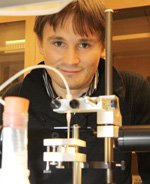New Nanomaterials Achievement Described
Materials science and engineering postdoc Damien Aureau delivered a recent presentation on nanostructured materials that was cited for its original ideas for achieving self-assembled molecules on semiconductor surfaces.

Titled “Patterning Flat Silicon Surfaces by Chemical Self-Assembly: Deposition of Nanomaterials,” his presentation occurred at the recent International Materials Research Congress.
Future devices for a wide range of applications – including biosensors, optics, catalysis, and electronics – are likely to use hybrid organic/inorganic junctions, he noted. One method commonly used to tether nanoparticles to a surface is to functionalize an oxidized silicon surface with silanes, molecules that form a self-assembling monolayer, or SAM. The formation of a SAM on oxide-free silicon can lead to higher chemical stability and better organization of the SAM on the surface.
A higher level of gold nanoparticle coverage was achieved using the oxide-free method compared to traditional methods, shown both by AFM and SEM imaging. The organic SAM layer also completely passivates the silicon surface and protects it from oxidation during treatment with nanoparticle solutions, making the final surface highly homogenous in chemical composition.
This high quality surface was used in experiments to study energy transfer through the organic layer. Data was shown that proved a monolayer of quantum dots was deposited on the surface of the silicon, a feat achievable because of the high quality organic interface. The quantum dot monolayer makes it possible to study the energy transfer from quantum dot to silicon without confounding the signal of transfer between quantum dots in different layers.
Aureau suggested this may find viable applications in photovoltaic technology and that the gold patterning could be used in developing a one-electron transistor using a gold nanoparticle as the electron island.




